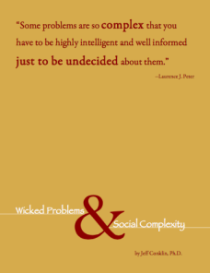Jeff Conklin: Wicked Problems and Social Complexity

This book is about collective intelligence: the creativity and resourcefulness that a group or team can bring to a collaborative problem.
Collective intelligence is a natural property of socially shared cognition, a natural enabler of collaboration. But there are also natural forces that challenge collective intelligence, forces that doom projects and make collaboration difficult or impossible. These are forces of fragmentation.
The concept of fragmentation provides a name and an image for a phenomenon that pulls apart something which is potentially whole. Fragmentation suggests a condition in which the people involved see themselves as more separate than united, and in which informa- tion and knowledge are chaotic and scattered.
The fragmented pieces are, in essence, the perspectives, understandings, and intentions of the collaborators. Fragmentation, for example, is when the stakeholders in a project are all convinced that their version of the problem is correct. Fragmentation can be hidden, as when stakeholders don’t even realize that there are incompatible tacit assumptions about the problem, and each believes that his or her understandings are complete and shared by all.
The antidote to fragmentation is shared understand- ing and shared commitment. This book is about a new way to create shared understanding, and this chapter sets the stage by exploring specific ways that the forces of fragmentation work in organizations and projects.
There is a subtle but pervasive kind of pain in our organizations. It is characterized by such frequently heard complaints as “How am I supposed to get my work done with all of these meetings?” and “We always have time to do it over again, but never time to do it right.” It is a sense of futility of expecting things to be one way and repeatedly banging into a different reality. It is the dull ache of déjà-vu when you are handed an impossible deadline or a vague assignment. It is the frustration of calling a meeting to make a decision and watching the meeting unravel into a battle between rival departments, or get lost in a thicket of confusion over the meaning of a technical term. It is the frustration of finally achieving a hard- won decision and then having it fall apart or get “pocket vetoed” because there wasn’t really buy in. It is the pain of fragmentation.
I was working late one evening when the janitor came in to vacuum the office. I noticed that he was going back and forth over the same areas without appearing to get the lint up off the carpet. I smiled and shouted to him (the vacuum cleaner was a loud one) “It must be frustrating to have to use that vacuum cleaner.” He looked at me with a sad smile and said “Not as frustrating as being told to go back and do it over!” It is that kind of pain, and it goes all the way up to the executive suite.
Part of the pain is a misunderstanding of the nature of the problems at hand. More precisely, the pain is caused by working on a special class of problems – wicked problems – with thinking, tools, and methods that are useful only for simpler (“tame”) problems. Problem wickedness is a force of fragmentation.
Most projects today have a significant wicked component. Wicked problems are so commonplace that the chaos and futility that usually attend them are accepted as inevitable. Failing to recognize the “wicked dynamics” in problems, we persist in applying inappropriate methods and tools to them.
Another force of fragmentation is social complexity, the number and diversity of players who are involved in a project. The more parties involved in a collaboration, the more socially complex. The more different those parties are, the more diverse, the more socially complex. The fragmenting force of social complexity can make effective communication very difficult. Social complexity requires new understandings, processes, and tools that are attuned to the fundamentally social and conversational nature of work.
For example, in a joint project involving several companies and government agencies, there was a prolonged struggle over the mission statement simply because of a terminology difference: each sponsoring agency had their own term for the core concept, and to pick one term meant disenfranchising one of the agencies. This is a very simple example of fragmentation of meaning.
Social complexity means that a project team works in a social network, a network of controllers and influ- encers including individual stakeholders, other project teams, and other organizations. These relationships, whether they are with direct stake- holders or those more peripherally involved, must be included in the project. For it is not whether the project team comes up with the right answer, but whose buy-in they have that really matters. To put it more starkly, without being included in the thinking and decision-making process, members of the social network may seek to undermine or even sabotage the project if their needs are not considered. Social complexity can be understood and used effectively, but it can be ignored only at great peril.